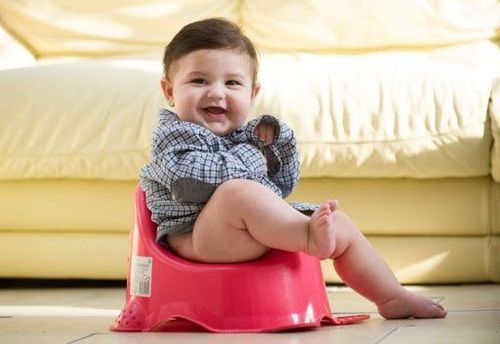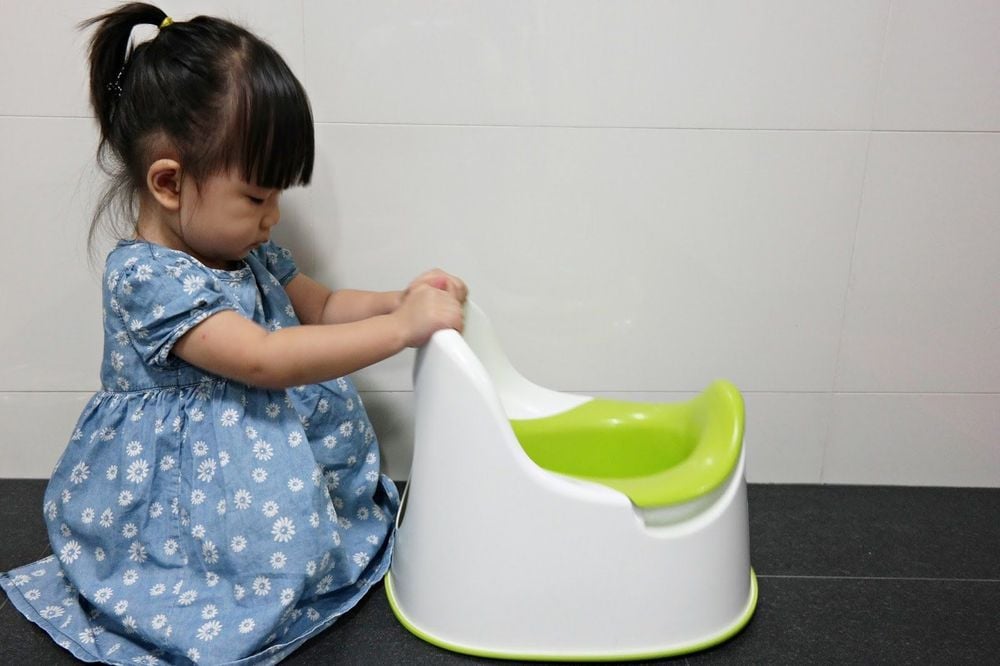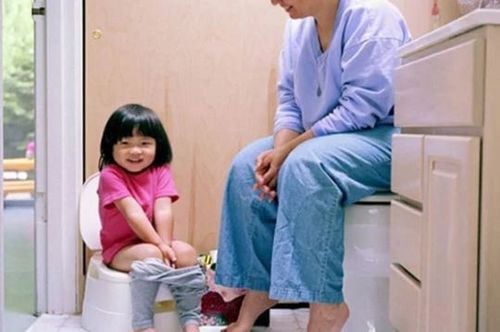This is an automatically translated article.
The article was consulted with Master, Doctor Doan Ngoc Quynh Tram - Pediatrician - Neonatologist - Department of Pediatrics - Neonatology - Vinmec Nha Trang International General Hospital.It may sound counterintuitive, however, a child can comfortably use the potty for just a few days or even an afternoon. For parents who have trained their children to sit on the potty for a long time with many difficulties, this is hard to believe. Here's how to potty train your child in 3 days - in Julie Fellom's program and instructions to help you do it effectively.
1. Are you ready to potty train your child?
It will take a lot of effort over a long period of time to help your child use the potty proficiently, independently and teach him step by step how to take his pants down and pull up, empty the potty and wash his hands after cleaning. So potty training for 3 days is like a stepping stone to the whole process. The most important thing to keep in mind is that there is no single best potty training method that works for you and your family.According to Fellom, a preschool teacher in San Francisco started the Diaper Free Toddlers program in 2006 after training more than 100 children on the potty. Her first motivation is to keep babies diaper-free by helping parents train their children to use the potty early. This method works for babies as young as 15 months old and works best for babies younger than 28 months old.
To participate in this program, parents need to attend a 2 hour class in the evening. Then, each family will do it themselves for 3 weekends at home.
Within 1-2 weeks after that, the child can sit on the potty to urinate or defecate without incident. If you can't attend Fellom's class, you can still do it yourself through this article "How to Train Your Child to Potty in 3 Days".
To be successful with this method, you need to have your child undressed at home. You can put diapers on your baby during nap time and at night, but the more dependent you are on those things, the less likely you are to make this training progress. If you really want to be effective, leave your baby naked. During the first 3 months, you do not need to put pants on your baby at home.
You will need to use a potty with a chair to use at home (ideally, keep one for each main area where you are often present, plus one in the bathroom), encouraging your child to drink plenty of water. In addition, you also need to prepare tools to clean up when an incident occurs along with a spare pair of pants for your baby when you have to go out.
Besides, it is necessary to prepare a towel or blotting paper on the car seat in case of an accident. You can cut a piece of cloth the size of a car seat and wrap it up before your baby sits in it. If the weather is cold, you can use a heater or have your child wear knee socks for them to wear when they are naked at home.

Bạn sẽ phải nỗ lực rất nhiều trong một khoảng thời gian khá dài để giúp con sử dụng bô thành thạo, độc lập
2. Potty training for three days
2.1. One month before start
Check to see if your baby is showing signs of being potty-ready. According to Fellom, signs can include a child who hasn't urinated for two hours or longer, likes to sit on the potty, doesn't like wearing diapers, and has a bowel movement at a regular time each day.After 28 months of age, children are often resistant to potty training, so this method is applied to children under 28 months of age. However, this method still works for older children.
According to Fellom, “when applied to children under 28 months, this method will be more effective. The effect decreases further when the child is 3 years old.”
Parents need to set a specific schedule and clear plan to spend the entire weekend (3 days) focusing on potty training. Cancel regular weekend activities and make sure someone is there to support you and train your child for at least the first 2 days.
You can create a dance that compliments your child's success and motivates him to keep going, this can be anything you find interesting and appealing to your child.
About 2 -5 weeks before potty training, start teaching your child about potty training. Whenever your spouse or any family member needs to go to the bathroom, bring your child along so that he or she can observe how people pull down their pants, sit on the toilet, pee or poop in it. clean yourself, pull up your pants, flush the toilet, and wash your hands afterward.
Baby will understand that it's fun and a family event when members use the potty while parents dance the "potty potty" dance. You can also use pets to illustrate the concept of potty training for your child. Show your baby when your pet goes to the toilet in the right place, such as in a small box or an outside area.
2.2. One week before start
Just have your baby look at the diaper and explain to her that, starting this Saturday (or whatever time you plan on doing this), she won't need diapers and can stay naked. Children will feel more interested and excited when you bring up this issue in a subtle way, such as “when these diapers are gone, you won't have to wear diapers anymore, you will be naked, you will feel comfortable. more comfortable".One of the reasons this method works so well is because children this age like to be naked. The purpose of the child is not to train the child to sit on the potty, but the problem is that the child can be naked, not wearing a diaper.
Day One Wake up with your baby as soon as he wakes up and keep him from having to wear pants throughout the day. You need to spend time observing the signs when your child wants to pee or poop. When your child starts to pee/poop, take him to the nearest potty. During the day, the child can eat more clothes or drink more water so that the child urinates more often.
Whenever you need to go to the bathroom, take your child with you. Show your child how you pull down your pants, sit on the toilet, poop or pee in it, pull up your pants, flush the toilet, and wash your hands after using the bathroom.
Don't forget to praise your child every time he succeeds on the potty. Children will often use the potty and use it more independently after 10-12 times.
When your child does not sit on the potty, you should not act indifferent. Instead, use a sad tone of voice, such as “you should pee in the potty” and help your child clean up by guiding her by the hand. However, do not make your child feel ashamed and pressured by scolding and threatening because doing so will happen again.
Before bedtime or at night, you need to remind your baby that it's time to sit on the potty. You can put diapers on your baby before going to sleep.
Day 2 Follow the instructions of day 1. The only difference is that you can go out for a walk with your child for about an hour in the afternoon. The next time your baby pees in the potty and then goes out immediately. You will help your child get into the habit of using the potty before leaving the house when applying this way.
When going out, children should wear comfortable clothes, not diapers. The goal is to reduce the risk of going out without using the potty.
Day 3 Follow the instructions on day 1, but on day 3 you can take your baby out for 1 hour and morning and afternoon. Let your baby sit on the potty first and then go when taking him outside. Remember to bring a small potty and some clothes to change your baby when needed.
2.3. After practice time
For the next 3 months, leave your baby naked at home (can wear diapers when needed). Please wear loose pants for your baby when going out, even when he goes to school. Cloth diapers and shorts give babies the same feel as diapers, allowing them to pee in their pants.After 3 months if there are no more incidents, the child can start wearing underwear and no longer need to be naked. When you go out with your child, remember to bring a small potty for your child and pay attention to the public restrooms outside. You can also use a public toilet seat for your child if you want (which is a chair that rests on top of the toilet to help children feel safer when using an adult-sized toilet) but this is not practical. the need. Instead, just keep your baby steady on the toilet seat and be sure to wash yours and your baby's hands after using the toilet.
If your child still won't use the potty after 3 days of training, you should wait another 6-8 weeks and try again later. According to experts, if the success rate is less than 75% or worse, you should stop potty training and try again later.

Nếu trẻ vẫn không dùng bô sau 3 ngày rèn luyện, bạn nên chờ thêm 6-8 tuần nữa và thử lại sau
3. Advantages and disadvantages of the 3-day potty training method
3.1. Advantage
This is considered an effective and easy method for babies who are just learning to use the potty. If you are concerned and confused about how to start or wondering how to get your baby to use the potty instead of just sitting on it, this is the way you should try.There will be some failures when applying this method, but Fellom's method usually gives results more quickly than many other methods. Fellom's method brings many benefits, such as: saving time and energy, children will be proud of their achievements and independence, and help you save money and protect the environment by How to remove diapers for babies earlier.
3.2. Defect
Staying at home for 3 days to observe every movement and help your baby sit on the potty will make you extremely tired. However, things will become easier when your baby learns to sit on the potty after 1-3 days of training.For busy people, if the method doesn't work the first time, it means you will have to take more days off. The requirement of this method is for the baby to be naked, but this will be inconvenient when you live in cold areas, especially in winter.

Việc ở nhà suốt 3 ngày để quan sát mọi cử động và giúp bé ngồi bô sẽ khiến bạn vô cùng mệt mỏi
4. Some tips for successful potty training
In order for Fellom's method to work best, parents should follow the tips below.Do not delay, you have decided to do it on the weekend, you must do it at the end of the week. Don't spend too much time worrying and thinking. Because your own thinking can make things more complicated. There comes a time when you ask yourself 'if it was this easy, I would have done it a long time ago'. This method helps children to dispel their fears, and at the same time relieves you of your mind about potty training. Choose an easy-to-clean place in the house such as wooden floors, tiles or floor mats... Let your children participate. Engage in a variety of activities and toys to keep your child comfortable. Let your children feel happy and excited. Always think in your head that "it is better to endure 3 tiring days than to last many months". In addition to Fellom's method, you can refer to some more ways below, which may be more suitable and effective for you:
Instead of a dance, you can reward your child in another way when he or she is willing to sit on the potty. like stickers, favorite food... Instead of taking your child to the bathroom with you, use a doll to illustrate the process of peeing/pooping in the potty. You can find more support on other websites or books from experts. And if you don't find these methods suitable, there are many other options for you. In addition, there are also many ways to train children to sit on the potty slowly for toddlers and older children. Find out more information online, as well as signs that your baby is potty-ready, how to start, do's and don'ts, troubleshooting, and training boys and girls with much more useful information.
Children in the period from 6 months to 3 years old are very susceptible to respiratory problems, respiratory infections, skin diseases and gastrointestinal infections... parents need special attention attention to the care and provision of adequate nutrition for children. For children to be healthy and develop well, it is necessary to have a nutritious diet in terms of quantity and quality balance. If children are not provided with adequate and balanced nutrients, it will lead to diseases of excess or lack of nutrients, which adversely affect the comprehensive development of children in terms of physical, mental and motor skills.
Parents should supplement their children with supportive products containing lysine, essential micro-minerals and vitamins such as zinc, chromium, selenium, and B vitamins to help fully meet their child's nutritional needs. At the same time, these essential vitamins also support digestion, enhance nutrient absorption, help improve anorexia, and help children eat well.
Parents can learn more:
Signs of zinc deficiency in children
Micronutrient deficiency and failure to gain weight in children
Please regularly visit Vinmec.com website and update useful information to take care of your child. Take care of the baby and the whole family.
Reference source: babycenter.com














